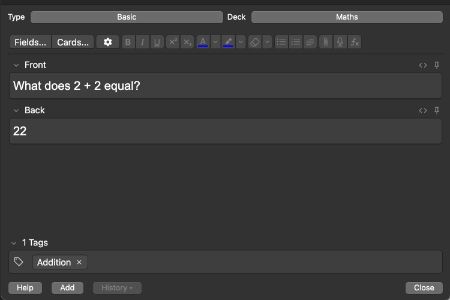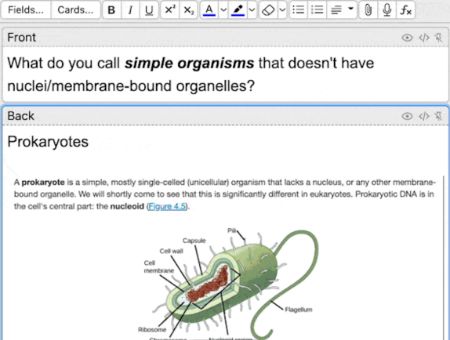How to Make 👩💻 Anki Flash Cards
Leananki.com says the best Anki card type is one most appropriate for the information being learnt. Usually, that is a basic card featuring a question and an answer …

NB: We need to review the following rules. Is it that clear-cut?
Bad Flashcards 🫵
- Statement cards with the term on front and the definition on back — because statements are not questions.
- Essays of text or 'brain dumps' of information are time-consuming. Split into cards containing single ideas (not fact) and fewer words.
- Cloze deletions/Image occlusions/Reversed types are for advanced use as they focus on remembering the card — not the idea behind it (however, this advice appears to contradict Rule #5 of formulating knowledge).
- ‘Shopping lists’ of information — as working memory can be overloaded if there are too many items at once. Cf., memory palaces or mnemonics.
- Multiple choice cards train recognition not recall. Make them only if you use the answer rather than the letter (exam has to be MCQ, obviously).
- Binary cards — Yes/No, True/False are worse than MCQ’s for learning because they have patterns and there's always a
50per cent chance, regardless.
Better Flashcards 🫵
- Fact based — terms are constructed to convey meaning on their own and you learn root word meanings or get to use facts in a bigger context
- Complex information requires conceptual understanding — don't just learn maths formulas through repetition — understand how they are used.
- Don't make cards for each step before learning the whole process. Compress processes into less but larger chunks/patterns — make diagrams without looking at the source to see if you understand before making the cards.
- In
tags, replace name spaces with_underscores.
Cards have to be questions, not statements.
e.g., If you have a definition and corresponding labelled diagram, the card should include the Question, Answer, Screenshot and Tag. You can add new lines to the ‘Back’ field for extra info like mnemonics or screenshots like …

For the best cards, you need …
- A specific question
- A specific answer
- A screenshot of the source
- A tag/s (optional)
Italicise and bold as cues for more salient answers — making terms easier to process.
- Do not use full paragraphs in a card.
- Do not use 'Explain' type questions.
- Do not use complex concepts in cards — KISS — for you.
e.g., What are Newton’s Three Laws of Motion?
- What is Newton’s First Law of Motion?
- Which Newton's Law of Motion is
F=ma? (another angle — redundancy). - What is Newton’s Third Law of Motion?
Habit goal — when waiting in a queue, or just bored, answer
5-20cards — convert idle time into learning time!
- Use tags to filter!
- Use the spacebar!
- Do not miss days!
- ↜ Previous: Rules for Effective 🙇 Learning
- ↝ Next: Grit: The Power of Passion ❤️🔥 Persistence